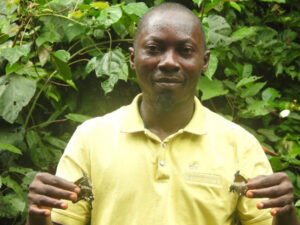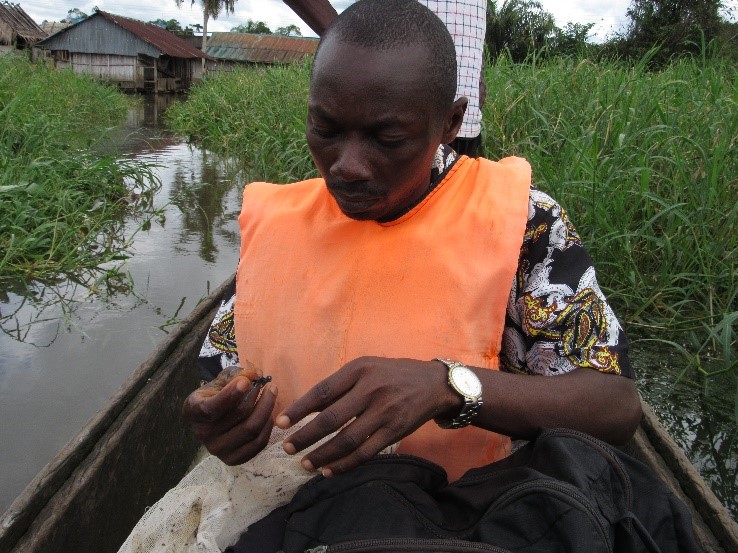University of Oxford
11a Mansfield Rd
OX1 3SZ
UK

Ojonugwa Ekpah
Background
My biodiversity conservation actions go beyond my official responsibilities; being propelled by passion and personal drive. For example, while my official duties as stipulated by NCF is limited to the Lekki Conservation Centre (in Lagos Nigeria) involving tour guiding and species monitoring, I have used my personal resources and grants to visit other biodiversity hotspots in Nigeria to carry-out conservation projects. Interestingly, in 2018 I applied to the School of Geography and the Environment (University of Oxford) to study Master of Science in Biodiversity, Conservation and Management. The application was however unsuccessful due to lack of sufficient skills. I was not discouraged by this failure but rather put in more efforts. I have since developed my skills and experience from 2018 with evidence of achievements in biodiversity conservation project management and field survey. In addition to the A. G. Leventis African Biodiversity fellowship, I am confident that I will acquire more skills and experience to contribute immensely to the protection of species in Nigeria especially the citizen science project I am developing.
Research Interests

From my frequent interactions with nature, I realized that there is more to discover especially regarding insects. I first began by looking within me, then to my immediate environment. I observed butterfly flying in a changing habitat ensued by man. I then extended my survey from human disturbed habitats to intact forest and made more discoveries. I came across rare species of butterflies, understood their needs, discovered threats to their habitat and then asked some questions. I was also determined to discover a species of butterfly which is new to science so that I could put my name on it.
I am further attracted to the adventures that follow my field trips. Sometimes I have to climb up tall mountains, see different landscapes and waterfalls. Some of these experiences could be challenging. For example, the road networks to many Nigerian forests are bad. There is also fear of insecurity. Professionally, I am attracted to activities related to biodiversity conservation education to people living in and/or near forest areas using insects as the target species. This is due to the great ignorance of ecosystem function of these species. For example, when the word, ‘insect’ is mentioned, many people think of the mosquitoes and other biting flies. Little information is available to them on the role of bees as pollinators, the dragonflies as mosquito predators and butterflies as ecotourism instrument. This knowledge gap is responsible for their inability to consciously protect their forest hence the high level of anthropogenic activities including the use of pesticides on farmland near forest. I would like to be a catalyst who will bring about change to the rising level of environmental degradation.
Current Research
My current research involves all aspects of butterfly taxonomy and how ecology shapes their features, function and communities. I am able to do this by regular field trips to Nigerian forest areas to monitor butterflies and the ecosystem dynamics in their microhabitat. Since conservation strategy cannot be planned for an unidentified species, I am able to conveniently identify the species using morphological features. However, the best methodology is to combined morphological information of the species with its genetic traits for a complete classification. I therefore, look forward to working more on the phylogenetic analysis of tropical butterflies in the nearest future. One of the research questions would be if Nigeria butterflies genetically adapt to anthropogenic activities.
Research Funding and Grants
Dec 2020 The Rufford Foundation – Insect Conservation
Mar 2019 British Entomological and Natural History Society grant – Insect inventory
Nov 2019 IDEALWILD – Insect inventory
May 2018 WWF Prince Bernhard – Study grant
July 2017 Aspire Coronation Trust – Waste management
Presentations
November 11-25, 2020- Oral presentation at The Entomological Society of America (ESA) annual meeting.
November 11-25, 2020- Poster presentation at The Entomological Society of America (ESA) annual meeting
Papers
Ekpah, O., Adu, B. W. and Kemabonta, A. K. (2020). An inventory of Odonata in relation to water quality in Lekki Conservation Centre, Nigeria. British Journal of Entomology and Natural History 33(4):367-382.
Ekpah, O., Kemabonta, K. A., Ogbogu, S. S. and Fomekong-Lontchi, J. (2020). Records of lost and associated species of Odonata in Cross River National Park, Nigeria Odonatologica 49(3/4): 245 – 258
Babasola Williams Adu, Owolabi Bibitayo Ayobami, Alafia Azeezat, Judicaël Fomekong-Lontchi, Kehinde Kemabonta, Ken Knapp, Sylvester S. Ogbogu, Ekpah Ojonugwa, Sévérin Tchibozo, Nene Ugbah, Gavin Campbell, Rhema Uche-Dike, Erasme Uyizeye, Jessica L. Ware, and Damion Whyte (2020) The Black Odonatologist’s Working Group ARGIA 32:3.
Ekpah Ojonugwa, Kehinde A. Kemabonta, Klaas-Douwe Dijkstra, Sylvester S. Ogbogu, Judicaël Fomekong-Lontchi, and Clifford Omonu (2021). Odonata from two Western Nigeria rainforests, with a record of the rare Ceriagrion citrinum Campion, 1914. IDF report
Ekpah Ojonugwa (2022). Wildlife status and ecotourism potentials of Lekki Conservation Centre, Lagos, Nigeria. Journal of Sustainable Tourism and Entrepreneurship, 2(4), 199-212.
I desire to join the programme as an A. G. Leventis African Biodiversity fellow so that my biodiversity protection skills will be explored and refined through the interaction with experts at the University of Oxford. I will also acquire new skills in protected area management using butterflies as the key species through the exchange of ideas with experts in the University of Oxford. I will bring in my datasets (e.g. butterfly habitat preference, results from bait trap protocol, etc.) along with the over 200 photos of butterflies taken from different forest areas in Nigeria. There are also butterflies photos taken by other Nigerian citizen scientists which I have collated. I will then organized these data and in addition to the other data which will be obtained during the training in the University of Oxford, I will realise the potential of the dataset and hence develop new ideas.
The fellowship will give me the opportunity to network with resource persons of like passion in the University of Oxford. Professor Owen Lewis who is one of my potential mentors in the fellowship has started sharing ideas with me already. At the end of the fellowship, I will come back to Nigeria and train other early career conservationist and provide mentorship.
Is there a specific project you will be working on while you are with us? Can you tell us a little about it?
Habitat fragmentation in Nigeria put pressure on butterfly species making them move towards forest however, some species of butterfly can adapt to degraded forests. To understand how butterfly diversity changes from human disturbed habitat to protected forests, butterflies were surveyed from human residential area to Omo forest reserve, southwestern Nigeria and a quick visit to the Oban division of the Cross River national park, Afi wildlife sanctuary, Becheeve nature reserve in Obudu, Okomu national park and Sokponba forest reserve in Nigeria. Butterflies were sampled by opportunistic encounter along forest paths using sweep net and butterfly baited trap. Photographic evidence were also obtained. A total of over 200 species of butterflies were encountered including the rare Euptera elabontas and Euphaedra zaddachii. There is also an unnamed species observed in Omo forest in the Demetra sub-group although it was not the first observation as a team of researchers had reported it. A list of the butterfly species which are able to thrive in human dominated areas, those that can adapt to moderate disturbances as well as species that are strict forest butterflies were record. Some butterfly species came to trap. Rare species of butterflies are restricted to the forest. These data will be brought into the fellowship in the University of Oxford.
